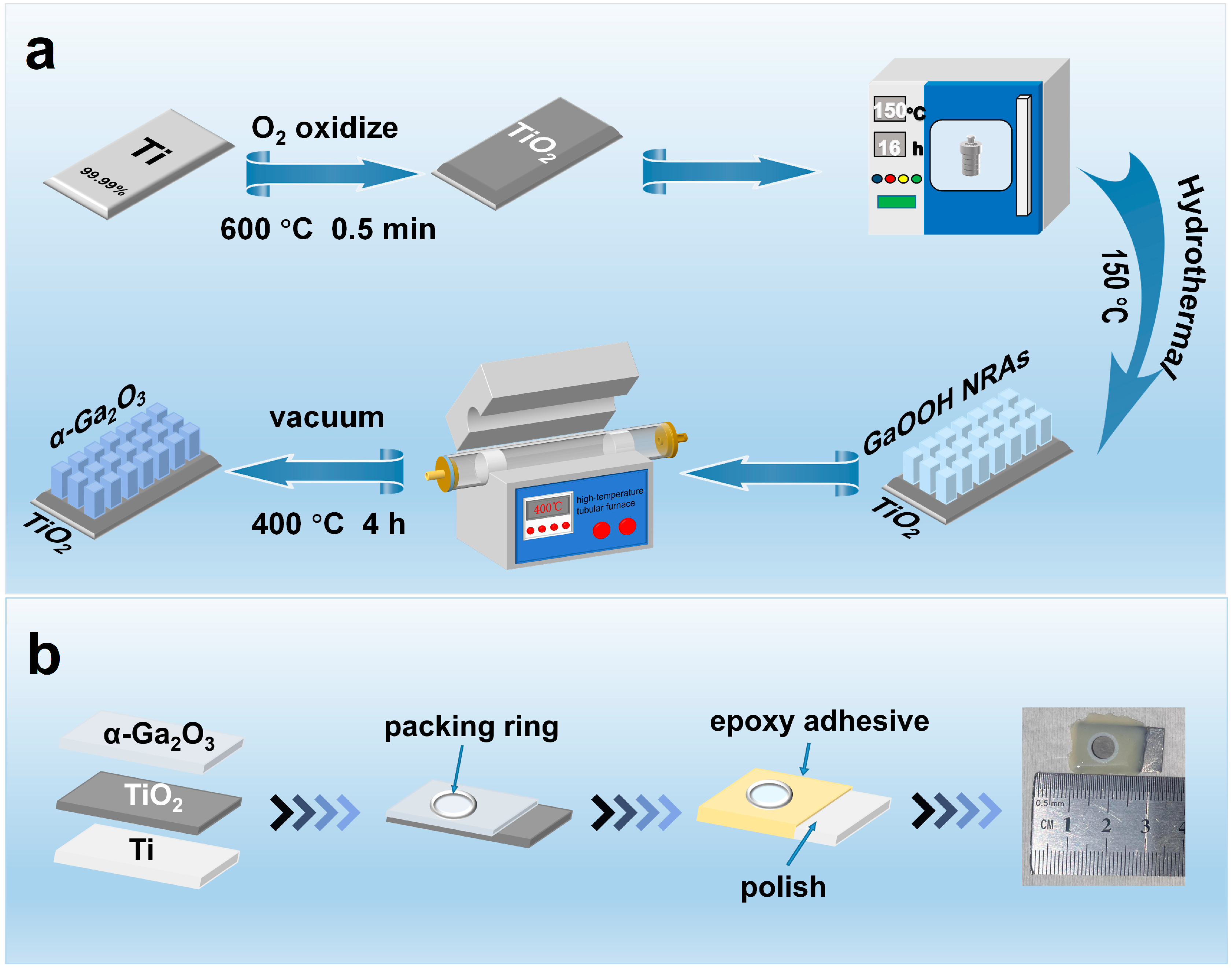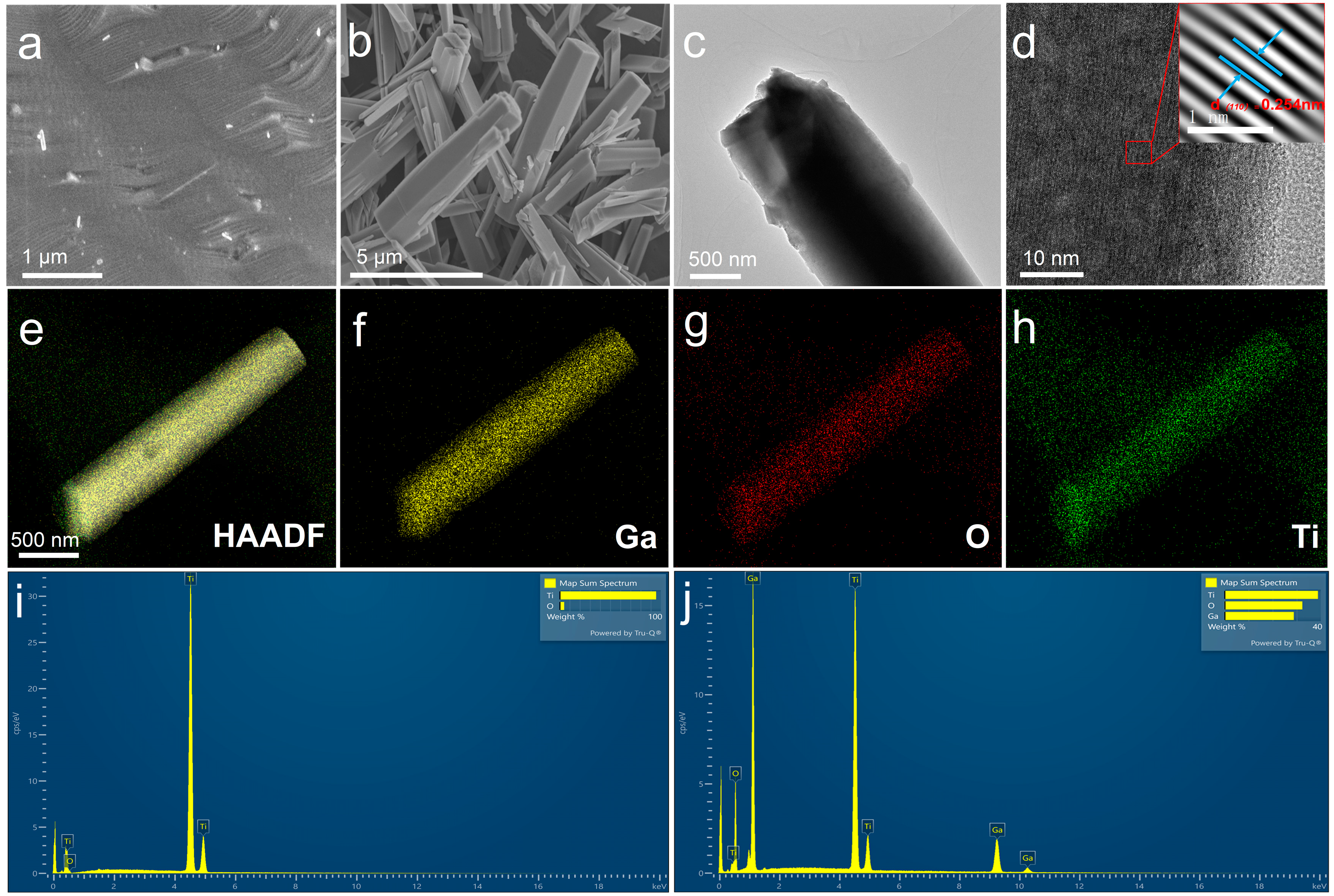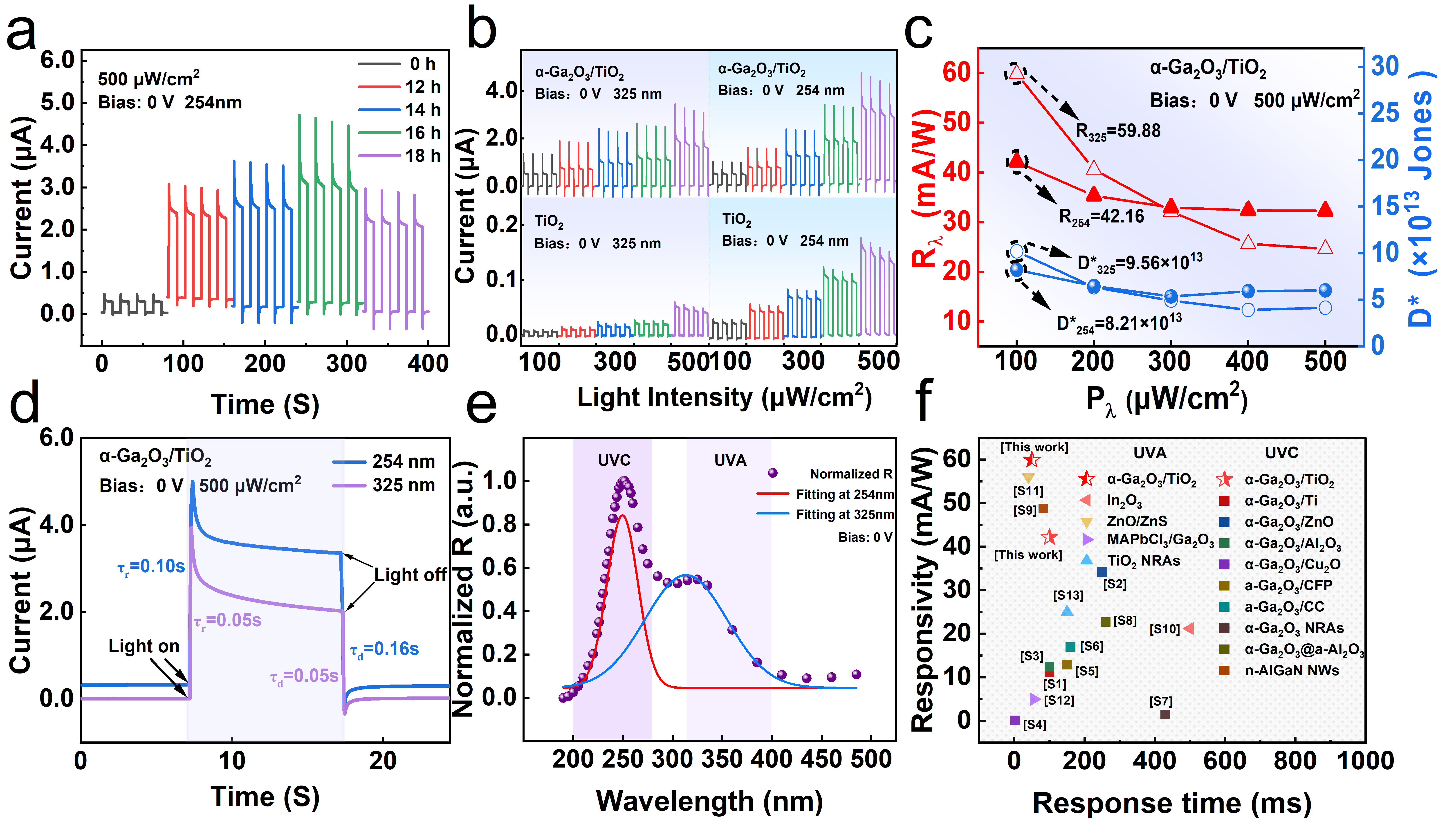A Facile Synthesis of TiO2–α-Ga2O3-Based Self-Powered Broad-Band UVC/UVA Photodetector and Optical Communication Study
Abstract
:1. Introduction
2. Experimental Process
2.1. Material Preparation
2.2. Characterization
3. Results and Discussion
4. Conclusions
Supplementary Materials
Author Contributions
Funding
Institutional Review Board Statement
Informed Consent Statement
Data Availability Statement
Conflicts of Interest
References
- Li, Z.; Yan, T.; Fang, X. Low-dimensional wide-bandgap semiconductors for UV photodetectors. Nat. Rev. Mater. 2023, 8, 587–603. [Google Scholar] [CrossRef]
- Deng, X.; Li, Z.; Cao, F.; Hong, E.; Fang, X. Woven fibrous photodetectors for scalable UV optical communication device. Adv. Funct. Mater. 2023, 33, 2213334. [Google Scholar] [CrossRef]
- Jalal, R.; Ozel, K.; Atilgan, A.; Yildiz, A. UV photodetectors based on W-doped ZnO thin films. Nanotechnology 2024, 35, 265705. [Google Scholar] [CrossRef]
- Chen, X.; Bagnall, D.; Nasiri, N. Capillary-Driven Self-Assembled Microclusters for Highly Performing UV Photodetectors. Adv. Funct. Mater. 2023, 33, 2302808. [Google Scholar] [CrossRef]
- Lin, X.; Wan, L.; Chen, Z.; Ren, J.; Lin, S.; Yuan, D.; Sun, W.; Peng, B. Dual-coupling effect enables a high-performance self-powered UV photodetector. Opt. Express 2024, 32, 4627–4638. [Google Scholar] [CrossRef]
- Zhang, X.; Li, Z.; Yan, T.; Su, L.; Fang, X. Phase-modulated multidimensional perovskites for high-sensitivity self-powered UV photodetectors. Small 2023, 19, 2206310. [Google Scholar] [CrossRef]
- Lin, Z.; Lin, T.; Lin, T.; Tang, X.; Chen, G.; Xiao, J.; Wang, H.; Wang, W.; Li, G. Ultrafast response self-powered UV photodetectors based on GaS/GaN heterojunctions. Appl. Phys. Lett. 2023, 122, 131101. [Google Scholar] [CrossRef]
- Yang, X.; Lin, J.; Huang, S.; Lin, X.; Xie, Y.; Yan, F.; Zheng, W.; Kong, X.; Hu, Q. Semiconductor applications of Yb2O3: Constructing heterojunction solar-blind UV photodetectors with graphene. Appl. Phys. Lett. 2023, 123, 081103. [Google Scholar] [CrossRef]
- Yang, Y.; Liu, X.; Liu, T.; Chen, D.; Ye, Z.; Li, J.; Huang, Q.; Zhu, Y.; Pang, Y.; Zhang, D. High-Speed Broadband Hybrid Perovskite Nanocrystals/Ge Photodetector from UV to NIR. Adv. Opt. Mater. 2023, 11, 2300708. [Google Scholar] [CrossRef]
- Siles, P.F.; Gäbler, D. Quantification of UV Light-Induced Spectral Response Degradation of CMOS-Based Photodetectors. Sensors 2024, 24, 1535. [Google Scholar] [CrossRef]
- Chen, Z.; Lin, X.; Lin, S.; Ren, J.; Wan, L.; Peng, B. Inverted-Structural Self-Powered Gan/PZT/ITO UV Photodetector Enhanced by Ferroelectric Modulation. Adv. Electron. Mater. 2024, 10, 2300588. [Google Scholar] [CrossRef]
- Yu, J.; Wu, G.; Han, X.; Liu, P.; You, S.; Yang, Q.; Hong, X. Amorphous Gallium Oxide Nanosheets with Broad Absorption and Spin Polarization for Si-Based UV–Vis–NIR Photodetectors. Adv. Opt. Mater. 2024, 12, 2302410. [Google Scholar] [CrossRef]
- Wu, S.; Wu, Z.; Tian, P.; Hoo, J.; Guo, S.; Fang, Z. High-performance (Al0.4Ga0.6)2O3/Al0.32Ga0.68N-based UVC/UVB tunable dual-band photodetectors. Cryst. Eng. Comm. 2024, 26, 2551–2559. [Google Scholar] [CrossRef]
- Wang, Z.; Gu, Y.; Liu, F.; Wu, W. Facile synthesis of wide bandgap ZrS2 colloidal quantum dots for solution processed solar-blind UV photodetectors. Chem. Commun. 2023, 59, 13771–13774. [Google Scholar] [CrossRef] [PubMed]
- Li, Z.; Li, Z.; Zuo, C.; Fang, X. Application of nanostructured TiO2 in UV photodetectors: A review. Adv. Mater. 2022, 34, 2109083. [Google Scholar] [CrossRef] [PubMed]
- Wang, H.; Ma, J.; Cong, L.; Song, D.; Fei, L.; Li, P.; Li, B.; Liu, Y. Solar-blind UV photodetector with low-dark current and high-gain based on ZnO/Au/Ga2O3 sandwich structure. Mater. Today Phys. 2022, 24, 100673. [Google Scholar] [CrossRef]
- Chen, K.-T.; Wang, C.-J.; Ke, Y.; Kao, Y.-C.; Chen, H.; Lin, Y.-S.; Han, J.; Lin, C.-F. Ultraviolet-C AlGaN Resonant-Cavity Light-Emitting Diodes with Thermal Stability Pipe-AlGaN-Distributed Bragg Reflectors. ACS Omega 2023, 8, 3478–3483. [Google Scholar] [CrossRef]
- Peng, D.; Li, Z.; Li, C.; Yang, Q.; Zhang, D.; Luo, W.; Dong, X. Low stress AlGaN/GaN heterojuction with AlGaN buffer grown on 6-inch semi-insulating SiC substrate. J. Cryst. Growth 2023, 611, 127184. [Google Scholar] [CrossRef]
- Tokai, S.; Yanagitani, T. Full-epitaxial ScAlN and MgZnO solidly mounted resonators based on epitaxial acoustic Bragg reflector. Appl. Phys. Lett. 2024, 124, 082901. [Google Scholar] [CrossRef]
- Wang, D.; Wang, P.; He, M.; Liu, J.; Mondal, S.; Hu, M.; Wang, D.; Wu, Y.; Ma, T.; Mi, Z. Fully epitaxial, monolithic ScAlN/AlGaN/GaN ferroelectric HEMT. Appl. Phys. Lett. 2023, 122, 090601. [Google Scholar] [CrossRef]
- Qian, L.X.; Li, W.; Gu, Z.; Tian, J.; Huang, X.; Lai, P.T.; Zhang, W. Ultra-Sensitive β-Ga2O3 Solar-Blind Photodetector with High-Density Al@Al2O3 Core–Shell Nanoplasmonic Array. Adv. Opt. Mater. 2022, 10, 2102055. [Google Scholar] [CrossRef]
- Liu, Z.; Wang, X.; Liu, Y.; Guo, D.; Li, S.; Yan, Z.; Tan, C.-K.; Li, W.; Li, P.; Tang, W. A high-performance ultraviolet solar-blind photodetector based on a β-Ga2O3 Schottky photodiode. J. Mater. Chem. C 2019, 7, 13920–13929. [Google Scholar] [CrossRef]
- Wang, Q.; Bao, J.; Zhang, Y.; Wang, Y.; Qiu, D.; Yang, J.; Zhang, J.; Gao, H.; Wu, Y.; Dong, H. High-Performance Organic Narrow Dual-Band Circular Polarized Light Detection for Encrypted Communications and Color Imaging. Adv. Mater. 2024, 36, 2312396. [Google Scholar] [CrossRef]
- Lu, Y.; Wang, B.; Yang, M.; Zhang, Q.; Jiang, Z.; Miao, T.; Zhang, N.; Zhang, J.; Guo, H.; Hu, H. Visible–infrared dual-band detection with a polarization sensitivity based on GeSe/Ge heterojunction field effect transistor. Appl. Phys. Lett. 2023, 123, 023504. [Google Scholar] [CrossRef]
- Bansal, S.; Das, A.; Jain, P.; Prakash, K.; Sharma, K.; Kumar, N.; Sardana, N.; Gupta, N.; Kumar, S.; Singh, A.K. Enhanced optoelectronic properties of bilayer graphene/HgCdTe-based single-and dual-junction photodetectors in long infrared regime. IEEE Trans. Nanotechnol. 2019, 18, 781–789. [Google Scholar] [CrossRef]
- Huang, Y.; Zhou, X.; Luo, L.; Zou, J.; Liu, H.; Li, X.; Ren, A.; Shen, K.; Wu, J. High-Performance Broadband Visible–Near Infrared Photodetector Enabled by Atomic Capping Layer. Adv. Opt. Mater. 2022, 10, 2200539. [Google Scholar] [CrossRef]
- Maurya, G.K.; Gautam, V.; Ahmad, F.; Singh, R.; Verma, S.; Kandpal, K.; Kumar, R.; Kumar, M.; Tiwari, A.; Kumar, P. Topological Insulator TlBiSe2/GaN Vertical Heterojunction Diode for High Responsive Broadband UV to Near-Infrared Photodetector. J. Electron. Mater. 2024, 53, 1561–1576. [Google Scholar] [CrossRef]
- Hanna, B.; Pillai, L.R.; Rajeev, K.; Surendran, K.P.; Unni, K.N.N. Visible-blind UV photodetectors using a polymer/ZnO nanocomposite thin film. Sens. Actuators A Phys. 2022, 338, 113495. [Google Scholar] [CrossRef]
- He, T.; Li, C.; Zhang, X.; Ma, Y.; Cao, X.; Shi, X.; Sun, C.; Li, J.; Song, L.; Zeng, C. Metalorganic Chemical Vapor Deposition Heteroepitaxial β-Ga2O3 and Black Phosphorus Pn Heterojunction for Solar-Blind Ultraviolet and Infrared Dual-Band Photodetector. Phys. Status Solidi A 2020, 217, 1900861. [Google Scholar] [CrossRef]
- Wang, L.; Jie, J.; Shao, Z.; Zhang, Q.; Zhang, X.; Wang, Y.; Sun, Z.; Lee, S.T. MoS2/Si heterojunction with vertically standing layered structure for ultrafast, high-detectivity, self-driven visible–near infrared photodetectors. Adv. Funct. Mater. 2015, 25, 2910–2919. [Google Scholar] [CrossRef]
- Zhang, Y.; Liu, S.; Xu, R.; Ruan, S.; Liu, C.; Ma, Y.; Li, X.; Chen, Y.; Zhou, J. Solar-blind ultraviolet photodetector based on Nb2C/β-Ga2O3 heterojunction. Nanotechnology 2024, 35, 165502. [Google Scholar] [CrossRef] [PubMed]
- Wu, C.; Wu, F.; Hu, H.; Wang, S.; Liu, A.; Guo, D. Review of self-powered solar-blind photodetectors based on Ga2O3. Mater. Today Phys. 2022, 28, 100883. [Google Scholar] [CrossRef]
- Zhang, Q.; Xu, J.; Li, M.; Chen, J.; Xu, J.; Zheng, Q.; Shi, S.; Kong, L.; Zhang, X.; Li, L. High-performance self-powered ultraviolet photodetector based on BiOCl/TiO2 heterojunctions: Carrier engineering of TiO2. Appl. Surf. Sci. 2022, 592, 153350. [Google Scholar] [CrossRef]
- Reddy, B.M.; Ganesh, I.; Khan, A. Stabilization of nanosized titania-anatase for high temperature catalytic applications. J. Mol. Catal. A Chem. 2004, 223, 295–304. [Google Scholar] [CrossRef]
- Hu, H.; Wu, C.; He, C.; Shen, J.; Cheng, Y.; Wu, F.; Wang, S.; Guo, D. Improved photoelectric performance with self-powered characteristics through TiO2 surface passivation in an α-Ga2O3 nanorod array deep ultraviolet photodetector. ACS Appl. Electron. Mater. 2022, 4, 3801–3806. [Google Scholar] [CrossRef]
- Gogoi, K.; Chattopadhyay, A. Surface Engineering of Quantum Dots for Self-Powered Ultraviolet Photodetection and Information Encryption. Langmuir 2022, 38, 2668–2676. [Google Scholar] [CrossRef] [PubMed]
- Lee, C.-T.; Lin, T.-S.; Lee, H.-Y.; Liu, D.-S. Dual-band ultraviolet photodetectors comprising nanostructured MgZnO on ZnO films. J. Vac. Sci. Technol. B 2018, 36, 061203. [Google Scholar] [CrossRef]
- Wang, G.; Zhang, X.; Li, J.; Bai, Z.; Wu, H.; Jin, M.; Zhou, J.; Xie, E.; Pan, X. A wire-shaped photoanode of the solar-blind photoelectrochemical-type photodetector based on an α-Ga2O3 nanorods/electrolyte solid/liquid heterojunction. Appl. Phys. Lett. 2023, 122, 071101. [Google Scholar] [CrossRef]
- Kumar, S.; Narayanan, T.S.N.S.; Raman, S.G.S.; Seshadri, S.K. Thermal oxidation of CP Ti—An electrochemical and structural characterization. Mater. Charact. 2010, 61, 589–597. [Google Scholar] [CrossRef]
- Qu, L.; Ji, J.; Liu, X.; Shao, Z.; Cui, M.; Zhang, Y.; Fu, Z.; Huang, Y.; Yang, G.; Feng, W. Oxygen-vacancy-dependent high-performance α-Ga2O3 nanorods photoelectrochemical deep UV photodetectors. Nanotechnology 2023, 34, 225203. [Google Scholar] [CrossRef]
- Zhang, B.; Wu, H.; Feng, C.; Zhang, Z.; Yu, H.; Zhang, C.; Lin, S.; Xu, C.; Bai, H.; Guo, F. Self-powered solar-blind photodetectors based on α-Ga2O3 nanorod arrays. ACS Appl. Nano Mater. 2022, 5, 11956–11963. [Google Scholar] [CrossRef]
- Liu, S.; Jiao, S.; Zhang, J.; Lu, H.; Wang, D.; Gao, S.; Wang, J.; Zhao, L. High-detectivity and sensitive UVA photodetector of polycrystalline CH3NH3PbCl3 improved by α-Ga2O3 nanorod array. Appl. Surf. Sci. 2022, 571, 151291. [Google Scholar] [CrossRef]
- Ni, S.; Chen, Q.; Liu, J.; Yang, S.; Li, T.; Yang, X.; Zhao, J. New insights into the Li-storage mechanism in α-Ga2O3 anode and the optimized electrode design. J. Power Sources 2019, 433, 126681. [Google Scholar] [CrossRef]
- Biesinger, M.C.; Lau, L.W.M.; Gerson, A.R.; Smart, R.S.C. Resolving surface chemical states in XPS analysis of first row transition metals, oxides and hydroxides: Sc, Ti, V, Cu and Zn. Appl. Surf. Sci. 2010, 257, 887–898. [Google Scholar] [CrossRef]
- Qin, Y.; Li, L.H.; Yu, Z.; Wu, F.; Dong, D.; Guo, W.; Zhang, Z.; Yuan, J.H.; Xue, K.H.; Miao, X. Ultra-high performance amorphous Ga2O3 photodetector arrays for solar-blind imaging. Adv. Sci. 2021, 8, 2101106. [Google Scholar] [CrossRef] [PubMed]
- Payne, B.P.; Biesinger, M.C.; McIntyre, N.S. X-ray photoelectron spectroscopy studies of reactions on chromium metal and chromium oxide surfaces. J. Electron Spectrosc. Relat. Phenom. 2011, 184, 29–37. [Google Scholar] [CrossRef]
- Payne, B.P.; Biesinger, M.C.; McIntyre, N.S. The study of polycrystalline nickel metal oxidation by water vapour. J. Electron Spectrosc. Relat. Phenom. 2009, 175, 55–65. [Google Scholar] [CrossRef]
- McCandless, J.P.; Chang, C.S.; Nomoto, K.; Casamento, J.; Protasenko, V.; Vogt, P.; Rowe, D.; Gann, K.; Ho, S.T.; Li, W. Thermal stability of epitaxial α-Ga2O3 and (Al,Ga)2O3 layers on m-plane sapphire. Appl. Phys. Lett. 2021, 119, 062102. [Google Scholar] [CrossRef]
- He, C.; Guo, D.; Chen, K.; Wang, S.; Shen, J.; Zhao, N.; Liu, A.; Zheng, Y.; Li, P.; Wu, Z. α-Ga2O3 nanorod array–Cu2O microsphere p–n junctions for self-powered spectrum-distinguishable photodetectors. ACS Appl. Nano Mater. 2019, 2, 4095–4103. [Google Scholar] [CrossRef]
- Zhu, X.; Wu, Y.; Li, G.; Zhang, K.; Feng, S.; Lu, W. Ga2O3–MXene nanowire networks with enhanced responsivity for deep-UV photodetection. ACS Appl. Nano Mater. 2023, 6, 2048–2062. [Google Scholar] [CrossRef]
- Politano, G.G.; Burza, S.; Versace, C. Cyclic Voltammetry and Impedance Measurements of Graphene Oxide Thin Films Dip-Coated on n-Type and p-Type Silicon. Crystals 2023, 13, 73. [Google Scholar] [CrossRef]
- Qin, Y.; Li, L.; Zhao, X.; Tompa, G.S.; Dong, H.; Jian, G.; He, Q.; Tan, P.; Hou, X.; Zhang, Z. Metal–semiconductor–metal ε-Ga2O3 solar-blind photodetectors with a record-high responsivity rejection ratio and their gain mechanism. Acs Photonics 2020, 7, 812–820. [Google Scholar] [CrossRef]
- Wang, Y.; Wu, C.; Guo, D.; Li, P.; Wang, S.; Liu, A.; Li, C.; Wu, F.; Tang, W. All-oxide NiO/Ga2O3 p–n junction for self-powered UV photodetector. ACS Appl. Electron. Mater. 2020, 2, 2032–2038. [Google Scholar] [CrossRef]
- Bansal, S.; Prakash, K.; Sharma, K.; Sardana, N.; Kumar, S.; Gupta, N.; Singh, A.K. A highly efficient bilayer graphene/ZnO/silicon nanowire based heterojunction photodetector with broadband spectral response. Nanotechnology 2020, 31, 405205. [Google Scholar] [CrossRef]
- Huang, L.; Hu, Z.; He, X.; Ma, T.; Li, M.; Zhang, H.; Xiong, Y.; Kong, C.; Ye, L.; Li, H. Self-powered solar-blind ultraviolet photodetector based on α-Ga2O3 nanorod arrays fabricated by the water bath method. Opt. Mater. Express 2021, 11, 2089–2098. [Google Scholar] [CrossRef]
- Huang, L.; Hu, Z.; Zhang, H.; Xiong, Y.; Fan, S.; Kong, C.; Li, W.; Ye, L.; Li, H. A simple, repeatable and highly stable self-powered solar-blind photoelectrochemical-type photodetector using amorphous Ga2O3 films grown on 3D carbon fiber paper. J. Mater. Chem. C 2021, 9, 10354–10360. [Google Scholar] [CrossRef]
- Dixit, T.; Agrawal, J.; Ganapathi, K.L.; Singh, V. Development of Dual-Band UV Photodetector Utilizing Nanostructured ZnO-ZnCr2O4. IEEE Photonics Technol. Lett. 2024, 36, 733–736. [Google Scholar] [CrossRef]
- Liu, W.; Deng, J.; Zhang, D.; Huang, L.; Hu, Z.; Zhou, S.; Zhang, H.; Ye, L.; Xiong, Y.; Kong, C.; et al. Construction of α-Ga2O3-ZnO heterojunction for a promoted performance applied in self-powered solar blind photodetector. Eur. Phys. J. Appl. Phys. 2022, 97, 57. [Google Scholar] [CrossRef]
- Zhang, D.; Zhou, X.; Xiong, Y.; Zhang, H.; Ye, L.; Pang, D.; Tang, Y.; Li, H.; Li, W. Flexible self-powered solar-blind UV photodetectors based on amorphous Ga2O3 modified carbon fiber cloth. J. Alloys Compd. 2023, 969, 172483. [Google Scholar] [CrossRef]
- Wang, X.; Xu, J.; Shi, S.; Kong, L.; He, X.; He, J.; Zhang, X.; Li, L. Self-powered solar-blind ultraviolet-visible Cu2O/Ga2O3 photodetectors. J. Mater. Chem. C 2024, 12, 8944–8951. [Google Scholar] [CrossRef]
- Tang, Q.; Tan, G.; Zhang, H.; Li, H.; Xiong, Y.; Pang, D.; Ye, L.; Fang, L.; Kong, C.; Li, W. Enhanced photoresponse of self-powered ZnO-based photoelectrochemical-type UV photodetectors via Ga-doping for optical communication application. J. Alloys Compd. 2024, 972, 172864. [Google Scholar] [CrossRef]
- Zhang, J.; Jiao, S.; Wang, D.; Gao, S.; Wang, J.; Zhao, L. Nano tree-like branched structure with α-Ga2O3 covered by γ-Al2O3 for highly efficient detection of solar-blind ultraviolet light using self-powered photoelectrochemical method. Appl. Surf. Sci. 2021, 541, 148380. [Google Scholar] [CrossRef]
- Chen, K.; Wang, S.; He, C.; Zhu, H.; Zhao, H.; Guo, D.; Chen, Z.; Shen, J.; Li, P.; Liu, A.; et al. Photoelectrochemical self-powered solar-blind photodetectors based on Ga2O3 nanorod array/electrolyte solid/liquid heterojunctions with a large separation interface of photogenerated carriers. ACS Appl. Nano Mater. 2019, 2, 6169–6177. [Google Scholar] [CrossRef]
- Wang, X.; Ding, K.; Huang, L.; Li, X.; Ye, L.; Luo, J.; Jiang, J.; Li, H.; Xiong, Y.; Ye, L.; et al. Enhancing the performance of Self-Powered Deep-Ultraviolet photoelectrochemical photodetectors by constructing α-Ga2O3@a-Al2O3 Core-Shell nanorod arrays for Solar-Blind imaging. Appl. Surf. Sci. 2024, 648, 159022. [Google Scholar] [CrossRef]
- Wang, D.; Huang, C.; Liu, X.; Zhang, H.; Yu, H.; Fang, S.; Ooi, B.S.; Mi, Z.; He, J.H.; Sun, H. Highly uniform, self-assembled AlGaN nanowires for self-powered solar-blind photodetector with fast-response speed and high responsivity. Adv. Opt. Mater. 2021, 9, 2000893. [Google Scholar] [CrossRef]
- Cui, M.; Shao, Z.; Qu, L.; Liu, X.; Yu, H.; Wang, Y.; Zhang, Y.; Fu, Z.; Huang, Y.; Feng, W. MOF-derived In2O3 microrods for high-performance photoelectrochemical ultraviolet photodetectors. ACS Appl. Mater. Interfaces 2022, 14, 39046–39052. [Google Scholar] [CrossRef]
- Lin, H.; Wei, L.; Wu, C.; Chen, Y.; Yan, S.; Mei, L.; Jiao, J. High-performance self-powered photodetectors based on ZnO/ZnS core-shell nanorod arrays. Nanoscale Res. Lett. 2016, 11, 420. [Google Scholar] [CrossRef] [PubMed]
- Liu, S.; Jiao, S.; Lu, H.; Nie, Y.; Gao, S.; Wang, D.; Wang, J.; Zhao, L. Polycrystalline perovskite CH3NH3PbCl3/amorphous Ga2O3 hybrid structure for high-speed, low-dark current and self-powered UVA photodetector. J. Alloys Compd. 2022, 890, 161827. [Google Scholar] [CrossRef]
- Xie, Y.; Wei, L.; Wei, G.; Li, Q.; Wang, D.; Chen, Y.; Yan, S.; Liu, G.; Mei, L.; Jiao, J. A self-powered UV photodetector based on TiO2 nanorod arrays. Nanoscale Res. Lett. 2013, 8, 188. [Google Scholar] [CrossRef]





Disclaimer/Publisher’s Note: The statements, opinions and data contained in all publications are solely those of the individual author(s) and contributor(s) and not of MDPI and/or the editor(s). MDPI and/or the editor(s) disclaim responsibility for any injury to people or property resulting from any ideas, methods, instructions or products referred to in the content. |
© 2024 by the authors. Licensee MDPI, Basel, Switzerland. This article is an open access article distributed under the terms and conditions of the Creative Commons Attribution (CC BY) license (https://creativecommons.org/licenses/by/4.0/).
Share and Cite
Zhang, W.; Xu, A.; Zhou, X.; Zhang, D.; Li, H. A Facile Synthesis of TiO2–α-Ga2O3-Based Self-Powered Broad-Band UVC/UVA Photodetector and Optical Communication Study. Materials 2024, 17, 4103. https://doi.org/10.3390/ma17164103
Zhang W, Xu A, Zhou X, Zhang D, Li H. A Facile Synthesis of TiO2–α-Ga2O3-Based Self-Powered Broad-Band UVC/UVA Photodetector and Optical Communication Study. Materials. 2024; 17(16):4103. https://doi.org/10.3390/ma17164103
Chicago/Turabian StyleZhang, Wenxing, Anqi Xu, Xin Zhou, Dan Zhang, and Honglin Li. 2024. "A Facile Synthesis of TiO2–α-Ga2O3-Based Self-Powered Broad-Band UVC/UVA Photodetector and Optical Communication Study" Materials 17, no. 16: 4103. https://doi.org/10.3390/ma17164103



